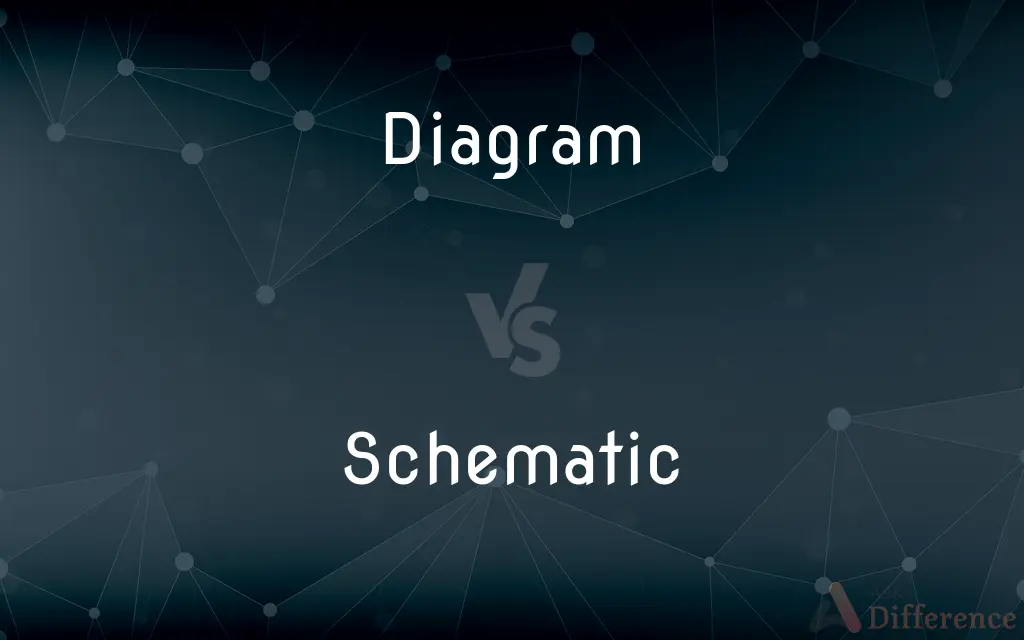Diagram vs. Schematic — What's the Difference?
By Tayyaba Rehman & Fiza Rafique — Updated on March 27, 2024
A diagram is a simplified graphical representation of concepts, objects, or systems, while a schematic is a detailed representation of the elements and connections within a system, often used in technical fields.

Difference Between Diagram and Schematic
Table of Contents
ADVERTISEMENT
Key Differences
Diagrams are versatile tools used across various fields to illustrate relationships, processes, or layouts in a simplified manner. They can be abstract or concrete, ranging from flowcharts and organizational charts to maps and architectural plans. Diagrams aim to clarify concepts, making them accessible to a broad audience. In contrast, schematics provide a more specialized representation focused on the details of a system's components and their interactions. Commonly used in engineering, electronics, and architecture, schematics are essential for understanding and building complex systems. They use standardized symbols to represent elements like circuits in electronic schematics, ensuring precision and uniformity across technical documents.
While diagrams are often used for educational purposes, conceptual understanding, or planning, schematics serve as precise guides for constructing, troubleshooting, or repairing systems. For example, a diagram might illustrate the general flow of electricity in a building, whereas an electrical schematic would detail the wiring, connections, and components necessary for the system to function.
The creation of a diagram is usually driven by the need to simplify and communicate general ideas or relationships, making them ideal for presentations, educational materials, or preliminary planning stages. Schematics, however, are developed with accuracy and technical specificity in mind, making them indispensable for professionals in technical fields who require detailed information about system configurations.
Despite their differences, both diagrams and schematics are crucial for visual communication. Diagrams provide a gateway to understanding the general principles or structures at a glance, while schematics offer the detailed data necessary for technical execution. The choice between using a diagram or a schematic depends on the purpose of the communication—whether to explain a concept broadly or to provide detailed instructions for technical processes.
Comparison Chart
Purpose
To simplify and illustrate concepts or processes
To detail components and connections in a system
ADVERTISEMENT
Use Cases
Education, presentations, planning
Engineering, construction, troubleshooting
Level of Detail
General, simplified
Highly detailed, technical
Audience
General public, students, managers
Technicians, engineers, architects
Symbols
Can be abstract or specific, less standardized
Highly standardized and specific
Representation
Abstract or concrete representations
Detailed representation of technical systems
Fields of Application
Any field, including business, education
Technical fields like electronics, architecture
Objective
To communicate ideas or relationships
To provide a guide for building or analysis
Examples
Flowcharts, organizational charts, site plans
Circuit diagrams, architectural schematics
Creation Driven By
Need to communicate or simplify
Need for accuracy and technical specificity
Compare with Definitions
Diagram
A graphical representation to illustrate concepts or processes.
The teacher used a Venn diagram to explain set theory.
Schematic
A detailed map of the elements and connections within a system.
The electrician followed the schematic to repair the wiring.
Diagram
Can be used in any field for a wide range of purposes.
The marketing team created a diagram to outline the campaign strategy.
Schematic
Serves as a guide for construction or troubleshooting.
The technician used a schematic to assemble the machine correctly.
Diagram
Variability in symbols and abstraction.
Mind maps are diagrams that represent thoughts or ideas around a central concept.
Schematic
Utilizes standardized symbols for precision.
Schematic symbols for electronic components are universally recognized.
Diagram
Aims to simplify and make information accessible.
An organizational chart diagram shows the company's structure.
Schematic
Requires technical knowledge to interpret.
Architectural schematics detail the structural elements of a building.
Diagram
Often used for educational or presentation purposes.
Diagrams of the water cycle are common in science textbooks.
Schematic
Essential for technical tasks in engineering and electronics.
Engineers use schematics to design and test circuits.
Diagram
A diagram is a symbolic representation of information using visualization techniques. Diagrams have been used since ancient times on walls of caves, but became more prevalent during the Enlightenment.
Schematic
A schematic, or schematic diagram, is a representation of the elements of a system using abstract, graphic symbols rather than realistic pictures. A schematic usually omits all details that are not relevant to the key information the schematic is intended to convey, and may include oversimplified elements in order to make this essential meaning easier to grasp.
Diagram
A simplified drawing showing the appearance, structure, or workings of something; a schematic representation
A diagram of the living room
Schematic
Of, relating to, or in the form of a scheme or diagram.
Diagram
Represent (something) in graphic form
The experiment is diagrammed on page fourteen
Schematic
A structural or procedural diagram, especially of an electrical or mechanical system.
Diagram
A plan, sketch, drawing, or outline designed to demonstrate or explain how something works or to clarify the relationship between the parts of a whole.
Schematic
Represented too simply or in an overly formulaic way, reflecting a shallow or incomplete understanding of complex subject matter
Diagram
(Mathematics) A graphic representation of an algebraic or geometric relationship.
Schematic
Sketchy, incomplete
Diagram
A chart or graph.
Schematic
Relating to a schema
Diagram
To indicate or represent by or as if by a diagram.
Schematic
A simplified line drawing used by scientists, engineers, technologists and others to illustrate a system at an abstract level. Schematic drawings often use standard symbols for clarity.
I'll have to study the schematics for the new integrated circuit before I can create a good layout.
Diagram
A plan, drawing, sketch or outline to show how something works, or show the relationships between the parts of a whole.
Electrical diagrams show device interconnections.
Schematic
Of or pertaining to a scheme or a schema.
Diagram
A graph or chart.
Schematic
Diagram of an electrical or mechanical system
Diagram
(category theory) A functor from an index category to another category. The objects and morphisms of the index category need not have any internal substance, but rather merely outline the connective structure of at least some part of the diagram's codomain. If the index category is J and the codomain is C, then the diagram is said to be "of type J in C".
Schematic
Represented in simplified or symbolic form
Diagram
(transitive) To represent or indicate something using a diagram.
Diagram
(UK) To schedule the operations of a locomotive or train according to a diagram.
Diagram
A figure or drawing made to illustrate a statement, or facilitate a demonstration; a plan.
Diagram
Any simple drawing made for mathematical or scientific purposes, or to assist a verbal explanation which refers to it; a mechanical drawing, as distinguished from an artistical one.
Diagram
To put into the form of a diagram.
Diagram
A drawing intended to explain how something works; a drawing showing the relation between the parts
Diagram
Make a schematic or technical drawing of that shows how things work or how they are constructed
Common Curiosities
Can a schematic be considered a type of diagram?
Yes, a schematic is a specific type of diagram focused on technical detail and standardization.
How are diagrams and schematics used differently in construction?
In construction, diagrams might be used for initial site planning and conceptual designs, whereas schematics detail the specific elements of building systems like electrical or plumbing.
Can anyone create a diagram?
Yes, anyone can create a diagram to illustrate or explain a concept. However, creating an accurate and effective schematic usually requires specialized knowledge.
Can the use of diagrams and schematics prevent errors in complex projects?
Yes, by providing clear visual representations and technical details, they can significantly reduce misunderstandings and errors in planning and execution.
Why are standardized symbols important in schematics?
They ensure consistency and accuracy, allowing professionals worldwide to understand and work with the schematics regardless of language barriers.
How important are diagrams and schematics in project planning?
Both are crucial: diagrams help in conceptualizing and communicating the project scope, while schematics provide the technical blueprint for execution.
Are diagrams or schematics better for learning?
Diagrams are typically better for initial learning and understanding concepts, while schematics are essential for in-depth technical studies.
How has technology influenced the creation of diagrams and schematics?
Technology has vastly improved the creation, sharing, and modification of both diagrams and schematics through software, making them more accessible and easier to produce.
Are there any universal standards for schematics?
Yes, many technical fields have developed universal standards for schematic symbols and presentation to ensure clear communication.
Do all fields use schematics?
Schematics are primarily used in technical fields where detailed information about system components and connections is necessary.
Share Your Discovery

Previous Comparison
Frill vs. Ruffle
Next Comparison
Abhorrent vs. RepugnantAuthor Spotlight
Written by
Tayyaba RehmanTayyaba Rehman is a distinguished writer, currently serving as a primary contributor to askdifference.com. As a researcher in semantics and etymology, Tayyaba's passion for the complexity of languages and their distinctions has found a perfect home on the platform. Tayyaba delves into the intricacies of language, distinguishing between commonly confused words and phrases, thereby providing clarity for readers worldwide.
Co-written by
Fiza RafiqueFiza Rafique is a skilled content writer at AskDifference.com, where she meticulously refines and enhances written pieces. Drawing from her vast editorial expertise, Fiza ensures clarity, accuracy, and precision in every article. Passionate about language, she continually seeks to elevate the quality of content for readers worldwide.















































